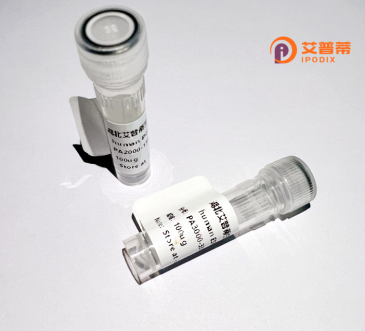
| 纯度 | >90%SDS-PAGE. |
| 种属 | Human |
| 靶点 | ORF1-FL49 |
| Uniprot No | Q9H1C7 |
| 内毒素 | < 0.01EU/μg |
| 表达宿主 | E.coli |
| 表达区间 | 1-97 aa |
| 活性数据 | MNQENPPPYPGPGPTAPYPPYPPQPMGPGPMGGPYPPPQGYPYQGYPQYGWQGGPQEPPKTTVYVVEDQRRDELGPSTCLTACWTALCCCCLWDMLT |
| 分子量 | 36.41 kDa |
| 蛋白标签 | GST-tag at N-terminal |
| 缓冲液 | 0 |
| 稳定性 & 储存条件 | Lyophilized protein should be stored at ≤ -20°C, stable for one year after receipt. Reconstituted protein solution can be stored at 2-8°C for 2-7 days. Aliquots of reconstituted samples are stable at ≤ -20°C for 3 months. |
| 复溶 | Always centrifuge tubes before opening.Do not mix by vortex or pipetting. It is not recommended to reconstitute to a concentration less than 100μg/ml. Dissolve the lyophilized protein in distilled water. Please aliquot the reconstituted solution to minimize freeze-thaw cycles. |
根据您提供的关键词,尚未发现明确以“重组人ORF1-FL49蛋白”命名的文献,但以下是与**L1 ORF1蛋白**(可能与FL49变体相关)相关的典型研究,供参考:
---
1. **"LINE-1 ORF1 Protein Enhances Alu Retrotransposition"**
*Author(s): Doucet et al.*
**摘要**: 探讨了重组人LINE-1 ORF1蛋白通过RNA相互作用促进Alu元件逆转录转座的作用机制,强调了其核酸伴侣功能。
2. **"Structural and Functional Analysis of the L1 ORF1 Protein"**
*Author(s): Khazina et al.*
**摘要**: 通过体外重组表达人L1 ORF1蛋白,解析其三聚体结构及RNA结合域,揭示了其在逆转座复合体组装中的关键角色。
3. **"Purification and Characterization of Human L1 ORF1p for Biochemical Studies"**
*Author(s): Martin et al.*
**摘要**: 报道了重组ORF1蛋白的高效原核表达系统,验证了其核酸结合活性及对L1 RNA稳定性调控的功能。
4. **"A Surveillance Function of the Human ORF1 Protein in Genomic Stability"**
*Author(s): Goodier et al.*
**摘要**: 发现ORF1蛋白通过与细胞应激颗粒互作抑制L1过度转座,可能在维持基因组稳定性中发挥保护作用。
---
**注**: 若“ORF1-FL49”为特定突变体或新型构建体,建议通过**PubMed/Google Scholar**检索完整名称,或补充基因/蛋白编号(如NCBI Accession Number)以精准定位文献。
The ORF1-FL49 protein is a recombinant, full-length human protein derived from the ORF1 (open reading frame 1) of Long Interspersed Nuclear Element-1 (LINE-1 or L1), a mobile genetic element responsible for retrotransposition in the human genome. LINE-1 elements encode two essential proteins: ORF1, an RNA-binding chaperone, and ORF2, which possesses endonuclease and reverse transcriptase activities. ORF1-FL49 corresponds to the 49 kDa isoform of ORF1, produced by alternative splicing, and is critical for LINE-1 retrotransposition. It contains conserved domains, including a coiled-coil motif for trimerization and a nucleic acid-binding domain, enabling its role in stabilizing LINE-1 RNA, forming ribonucleoprotein (RNP) complexes, and facilitating retrotransposition. Recombinant ORF1-FL49 is typically expressed in heterologous systems (e.g., E. coli or mammalian cells) for functional studies, allowing researchers to investigate LINE-1 biology, genomic instability, and its implications in cancer, neurodegeneration, and innate immune responses. Its study also contributes to understanding host defense mechanisms against retroelements and potential therapeutic strategies targeting LINE-1 activity.
×